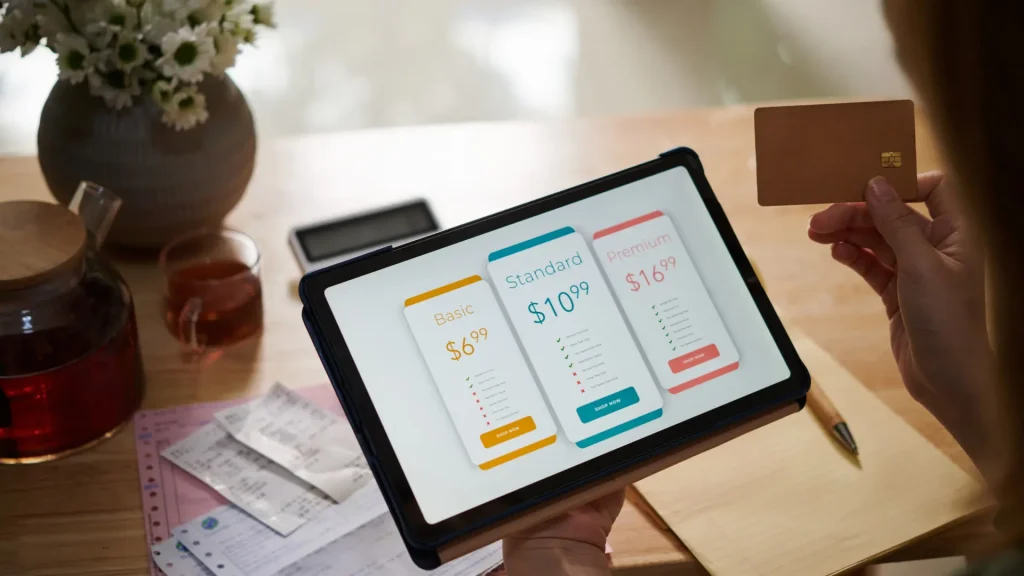Why Subscription-Based Tariffs Are Transforming Telecom Revenue and Retention Strategies
In today’s connected world the subscription model is no longer confined to media and entertainment. The subscription model now extends far beyond because people can access it through various everyday services including education, home security, access control and comfort services. Telecom operators who control service delivery and connectivity can benefit from this opportunity. Modern telecoms and ISPs create worldwide new revenue streams through telco subscription services to boost ARPU, decrease customer churn and enhance customer relationships.
The article explains how subscription-based models affect the telecommunications industry. We aim to show the development of subscription models through various examples from our customer’s cases. This report presents worldwide market trends and size forecasts for 2026 and explains why telcos need immediate action to increase ARPU and prevent customer loss. Get it to discover which service types show increasing popularity and why Aipix’s mission is to support this business approach. Aipix as a leading global VSaaS company delivers specific benefits to telcos and mobile operators and ISPs who use this subscription model.
Subscription model. General description
A basic subscription model requires customers to pay recurring fees (which can be monthly, quarterly or annually) to access services instead of making one-time payment, single purchases or paying based on usage. Telcos have used mobile voice/data packages as their core subscription model while introducing streaming bundles and device-financing plans in their advanced subscription offerings.
The discussion focuses on extending subscription-based services to everyday living-services. This can include comfort, security, access, control, connected devices, home automation, surveillance, smart-intercom systems through the telco network and powerful platform ecosystem.
In practical terms: instead of just “gigabytes/month”, a subscriber might pay a fixed fee for a bundle that includes connectivity + smart home monitoring + remote access control + concierge services.
The subscription bundle serves as a platform which generates ongoing revenue streams while maintaining customer loyalty. The predictability of subscription fees enables businesses to move away from one-time billing models which lead to customer churn because they focus on maximizing customer lifetime value (LTV).

The story of development & popular examples
The subscription economy has grown rapidly and become mainstream in media and entertainment first, then broadened.
For example:
Users worldwide subscribe to Netflix and Spotify through recurring payment plans instead of purchasing content ownership. Recent data shows digital subscription numbers continue to grow worldwide as services expand their user base to billions of people.
The overall subscription economy (SaaS) (media + software + services) was estimated at around USD 492 billion in 2024 and is projected to grow to over USD 1.5 trillion by 2033.
And what is there on the telco side? Operators now understand that customer loyalty and payment habits have become essential for their business operations. For example, the 2025 Global Telecommunications Study by Simon‑Kucher & Partners found that telcos only capture around 60 % of full customer value potential: loyalty (tenure) scores 6.6/10, and paying (ARPU) only 4.3/10.
In other domains, for example the subscription-e-commerce market (boxes, services), is also booming.
The examples demonstrate how subscription models have transformed customer behavior from buying products to experiencing service delivery and obtaining access to value. The telecommunications industry needs to adopt this new perspective. Telco and ISPs can get the path to delivering services that combine connectivity with devices, platforms and ecosystem management.
Popular examples of telco-based subscription services:
- Smart-home security: monitoring, cameras, alerts
- Access control: smart intercoms, remote door unlock, visitor management
- Home comfort: smart climate controls, connected appliances, predictive maintenance
- Bundled lifestyle connectivity: “connect everything at home” + video surveillance + concierge + premium data + video archive
The market conditions and technological capabilities exist for global telco companies to implement similar strategies although no major examples have emerged yet. Telco should get first-move advantage, unless the other companies (like financial institutions) take it instead.

Global trends in development across sectors of living (2026 and beyond)
Market size & growth potential in short statistics
- The global subscription economy is projected at USD ~$557.8 billion in 2025, with forecasts pointing to ~$1.944 trillion by 2035 (~3.5× growth).
- A recent source puts the 2024 value at USD 487 billion, growing at a CAGR of ~15.9 %.
- In the Asia-Pacific region alone the subscription economy market generated USD 111 billion in 2024 and is expected to grow at CAGR ~15.7% to 2033.
- Digital subscriptions (media and content) remain a large chunk: content subscriptions led the market in 2024, capturing over ~45% share.
Sector expansion
- Media & entertainment were the early adopters; now we see subscription models in software (SaaS), e-commerce (“subscription boxes”), connected home/IoT, security services, wellness, remote-monitoring, etc.
- In the living space this means everything from home security (cloud video surveillance, smart locks), smart-home comfort (climate, lighting, appliances), access control (smart intercoms, visitor-management), to lifestyle connectivity bundles.
- Telcos are uniquely positioned in telco subscription services because they provide connectivity + devices + platforms + billing capability. Convergence of fixed-mobile, broadband, IoT means operators can deliver “service bundles” not just “connectivity”. The Simon-Kucher study shows fixed-mobile convergence (FMC) can deliver 26-51% higher ARPU.
Why 2026 and beyond matter in the subscription model.

As more devices become connected (smart home IoT, 5G/6G rollout, edge computing), consumers will expect managed services, not just self-install kits.
Subscription fatigue is a risk but also an opportunity: smart bundles with high value and convenience will win. So, the Telcos that pivot to service-led subscriptions can differentiate from pure connectivity providers and reduce reliance on price competition.
Value-share of subscription-based services and strategic importance for telcos
For telcos, capturing the “living-services” subscription market means expanding ARPU beyond data/voice. The other core telco metrics – churn rate – is reduced when services are integrated into daily life (home security, access control) and become “sticky”.
So after all, all the new revenue streams (home monitoring, smart intercom, managed IoT services) complement traditional telco packages and shift focus from one-time device sales to recurring revenue.
Why telco should get in SaaS: ARPU growth and churn strategy
ARPU growth tools in telco
Operators focus on boosting their average revenue per user (ARPU) because it generates better financial results than acquiring new customers. The Simon-Kucher study shows that telcos fail to maximize revenue from their current customer base because ARPU (Paying) scores only 4.3 out of 10. So in the growing ARPU strategy the subscription model is guaranteed to generate stable monthly payments to help operators decrease their dependence on occasional usage surges while offering premium service options. The combination of connectivity services with additional offerings through bundling makes services appear less expensive to customers which leads to successful upselling opportunities. Moreover, the operator wins the increased pricing as they provide both essential connectivity services and additional value-added services to their customers.
Churn reduction tools in telco
The implementation of subscription services creates “stickiness” for telco’s subscribers. Once they become part of their daily routine, the users find it difficult to leave their home security, smart intercoms and premium access control systems. The process of keeping current customers proves more cheaper and efficient than attracting new ones. The Simon-Kucher report demonstrates that customer retention costs ten times less than customer acquisition does.
Moreover, thanks to premium service tiers and bundled packages telecommunication businesses can create separate customer segments for further business development strategy planning. The correct strategy decreases the number of customers who will leave for other opportunities. The subscription model enables companies to evolve from basic connectivity providers into daily life partners. As a result it strengthens both emotional and practical customer loyalty.
Strategic fit for telcos
Telcos uniquely possess billing systems and customer service platforms together with network management tools and device control systems. This results in experience with handling large operations and automated payment systems.
The transition to subscription-based services enables telecom industry businesses to use their current resources to access fresh revenue streams. The market trend toward commoditization of connectivity. It enables telcos to create value-added subscription services to differentiate their offerings and boost profit margins. So that telcos achieve extremely better profitability through customer lifecycle subscription integration which leads to higher ARPU, reduced churn rates and stronger customer loyalty.

Which lifestyle subscription-based services are getting popular in 2026
Here are key service categories gaining traction in subscription-based models and ripe for telco delivery indeed.
- Home security & surveillance (smart cameras, 24/7 monitoring, alerts, remote access).
- Smart home comfort / automation (for example climate control, lighting, appliance monitoring/maintenance, predictive service).
- Access control & intercoms (like smart intercoms, door unlock via mobile, visitor-management systems, remote lock/unlock).
- Connectivity bundles + concierge services (e.g., “connected home” plan that includes higher speed/fibre + smart-home device + monitoring + support)
- Managed IoT services (e.g., wearables, home sensors, elderly care monitoring, asset tracking, pet trackers).
- Security & control for small business / home office (subscription for remote surveillance, smart locks, access audits, especially as hybrid work persists).
These categories work especially well for telcos because:
- The services need internet access which telcos already provide to their customers.
- The services need devices and hardware together with ongoing service fees which match perfectly with telco basic service packages.
- The services create dual benefits of emotional and functional value through security and control and comfort which leads to better customer retention.
Why Aipix adopts the philosophy of subscription-based services through telco
At Aipix we believe that the telco subscription services approach is the future of value creation for telcos. Our philosophy:
- Access-over-ownership is the dominant consumer mindset: people prefer to ‘subscribe’ for access, convenience and service rather than buying hardware outright or paying piecemeal.
- Telcos are ideally positioned to be the infrastructure + platform layer for living-services: connectivity, devices, billing, customer-care.
- Recurring revenue matters. Every month a subscriber remains, the telco monetises more; we focus on service-led loyalty rather than sheer acquisition.
- Service bundles drive differentiation. For example, in a crowded connectivity market, offering integrated subscriptions (home-security, smart-access, comfort) allows telcos to stand out.
- Platform and ecosystem. Aipix helps telcos build and ISPs to orchestrate service ecosystems, partner devices, manage subscriptions, billing, provisioning. It’s enabling quick go-to-market.
- Churn and ARPU improvement by shifting from single-dimensional offerings to multi-service subscriptions. Telcos raise ARPU and reduce churn, aligning with the strategic needs of operators today.
Telcos should view subscription service expansion as their main strategic move to develop into lifestyle service providers instead of maintaining their traditional connectivity focus.
Main advantages of Aipix for telecom, mobile operators and ISPs
Since 2017 Aipix VAS platform is proven to deliver revolutionary value to telecommunication companies, system integrators, mobile network operators and ISPs who want to implement subscription-based services through its features.
Key Aipix’s benefits in building telco subscription services ecosystem
- Plug-and-play subscription platform
Aipix provides operators with tools to support recurring billing via User Portal. It has usage tracking, tier management and device lifecycle management which allows them to introduce new subscription services at speed.
- Service-bundle creation & management
Aipix enables operators to develop adaptable bundles which combine network access with smart home devices, subscription-based services and additional premium service levels.
- Partner ecosystem and device integration
The scalable and Open API architecture of Aipix makes it possible to link smart-home and access-control devices through a single platform. It handles seamless device provisioning and multitenant network monitoring.
- Retention and loyalty tools
The system includes built-in analytics which enables churn prediction and upgrade prompt generation and tier-up sell trigger activation to boost customer lifetime value.
- Scalable across fixed, mobile
The platform is ideal for telecom operators with fixed-broadband, mobile network and IoT portfolios – enabling convergence (FMC) offers that have higher ARPU.
- Differentiation & new revenue streams
By enabling home-security, access-control, smart-comfort subscriptions, operators can move beyond “bits and bytes” and into lifestyle-services with higher perceived value.
Examples of subscription-based service use-cases
An operator offers a “HomeGuard” subscription: fibre-broadband + smart-home gateway + indoor/outdoor cameras + 24/7 monitoring + smartphone remote access for €19.99/month.
A mobile operator upsells a “SmartAccess” add-on: for €7.99/month you get a smart intercom device with door-unlock via app, visitor video feed, integrated with your mobile plan.
An ISP bundles “OldPersonComfortConnect”: unlimited WiFi + smart intercom via mobile access 24/7 + appliance old people in-house monitoring + monthly service review – for €12/month extra.
The operator transforms into a trusted service partner for customers through these types of services which extend beyond basic connectivity.
Conclusion
The subscription model has become standard in media and digital services while it continues to expand into regular household needs.
Telcos and ISPs should seize this chance to boost their ARPU, LTV, CPC and reduce churn rate through subscription-based service packages which include security, access and connectivity services.
The Aipix VSaaS platform supports telcos and ISPs worldwide to transform their business model from basic connectivity services to lifestyle-service partnerships. The industry needs immediate action because subscription-based services will dominate the market in the next decades. So that the operators who adopt telco subscription services will win the client battle and control future telco revenue growth.
Want to join the league of successful telecom companies? Leave the request and get a personal Aipix manager’s consultation!
Get your "VAS & VSaaS Report 2025"
Leave your e-mail and we’ll send you the file





